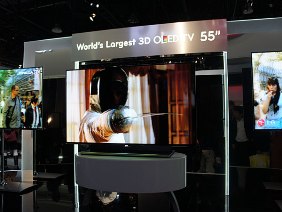We've seen the slew of TVs, smartphones, Ultrabooks, and other new products on the floor of the Consumer Electronics Show. Now it's time to pick out the best. These are our 20 favorite gadgets of CES 2012.
 |
| Roku Streaming Stick |
1. Roku Streaming Stick
Using the new HDMI MHL standard, the Roku Streaming Stick plugs into a port on newer TVs. It instantly gives any compatible set access to all of Roku's online content from providers such as Netflix, MLB, Pandora and Rdio. The stick requires no dedicated power, has WiFi built in, and should launch later this year for under $100.
 |
| Lenovo Yoga |
2. Lenovo Yoga
With both a traditional desktop mode and an all-new touchscreen Interface, Windows 8 represents the Microsoft's first complete rethink of the desktop operating system since 1995. The Lenovo Yoga is equal parts ultrabook and tablet; a 13-inch folding laptop with a multitouch capacitive touchscreen.
 |
| Dish Network's Hopper |
3. Dish Network's Hopper
Hopper is Dish's overhaul of the traditional DVR/Tuner set-top box, with three tuners and a huge 2TB internal drive that can hold 2000 total hours of programming. It's also got a fast, slick new interface, and includes a Zigbee wireless remote with a "remote control finder" alert to locate your clicker in the cushions. But the most innovative feature is "PrimeTime Anytime," which records every prime time show on all four major networks automatically in HD, and saves them for eight days, essentially automating the process of recording everything on television.
 |
| Griffin Twenty |
4. Griffin Twenty
The Griffin Twenty streaming audio device turns any Apple AirPort Express into a stereo system. The machine has a simple and elegant design, just a plug for the AirPort Express and a large, friendly white dial for volume. As its name implies, the Twenty has an internal 20-watt amplifier and outputs for left and right stereo speakers, plus a subwoofer. The concept is that the dial controls the volume, while the rest of the interface is taken care of through your iPhone, iPad or computer.
 |
| Sharp Freestyle Aquos TV |
5. Sharp Freestyle Aquos TV
Sharp's innovative new line of portable Freestyle TVs are ultra-thin and light, ranging from 20-inches to 60-inches diagonally. Freestyle TVs receive HD video over Wi-Fi, and they can be picked up, moved and placed anywhere around the house to anywhere there is a power plug. The 20-inch model even has an integrated handle and battery so that it can be taken anywhere.
 |
| Fujifilm X-Pro1 |
6. Fujifilm X-Pro1
Fujifilm's first entry into the interchangable lens camera (ILC) category is a stunner, a gorgeous slab of aluminum, synthetic leather, and precision-milled nobs and dials that manages to be featherlight, thanks to its magnesium build. The price is also a little stunning estimated to start at $1600 for the body alone, but the X-Pro1 is beautiful inside, too, with a new color filter array helps it meet, and sometimes exceed, the image quality of full-frame SLR sensors. The camera and three lenses will be out next month, with nine more planned over the next two years, as well as a mount for Leica lenses planned for later this year.
 |
| OLPC XO3 |
7. OLPC XO3
For most of us, tablets are toys, irresistible little windows onto a constellation of videogames and streaming video. The OLPC tablet, a collaboration between One Laptop Per Child and Marvell‹is for kids in developing nations, but it's not a plaything. It has all the best features of its laptop processor, including a Linux-based operating system, a rugged design, and the ability to recharge through solar panels or a hand crank, but at a targeted price of $100, it'll be nearly half the price. The product is ready to go into production as soon as a willing partner signs up.
 |
| Thermador Freedom Induction Cooktop |
8. Thermador Freedom Induction Cooktop
The Thermador Freedom Induction Cooktop is a technological leap forward for home cooking instead of discrete heating elements, the cooktop senses induction-compatible cookware placed anywhere on its surface. The touch-sensitive display shows where each pot and pan is situated, maintaining their power level even as they slide around. It also has a Boost feature, which redirects up to 30 percent of the power from one half of the surface to the other, for even faster heating.
 |
| Sony Network Media Player |
9. Sony Network Media Player
In a year when every TV maker seems to be building full Internet connectivity into their displays, Sony's Network Media Player powered by Google is a lifeline tossed back to all the poor, unconnected TVs already out there. It streams online video from services like Netflix and HBO Go, and can be controlled with an iOS or Android smartphone, but we're actually more excited about the hardware. The exclusive remote control has a full, backlit QWERTY keyboard on one side, and more traditional buttons on the other, with a less traditional trackpad. Other companies should sit up and take notice‹if you want to revolutionize the TV, start with a revolutionary remote. The player, and remote, will be out this summer, though prices haven't been announced.
 |
| Cadillac CUE |
10. Cadillac CUE
As cars become gadgets on wheels, automakers have been challenged to integrate cellular connectivity and complex user interfaces into the car. Some companies have stumbled, and some have excelled. With the Cadillac CUE, GM and Cadillac fall into the latter. With its capacitive, multi-gesture touchscreen, haptic feedback, cloud-based OnStar service, natural-speech recognition, attention to driver safety, and a flexible HTML 5 platform, the Cadillac CUE should serve as a benchmark for the rest of the automotive industry.
 |
| MakerBot Replicator |
11. MakerBot Replicator
Popular Mechanics has always been a magazine for the do-it-yourselfer, which is why we love the folks at MakerBot and their newest open-source 3-D printer, the MakerBot Replicator. Larger than the original MakerBot, the Replicator allows the amateur inventor to create objects roughly the size of a loaf of bread out of common manufacturing materials such as ABA or PLA. Also unlike the company's original 3D printer, the Thing-o-Matic, the new Replicator has the ability to print in two separate colors. And at $1749, the MakerBot Replicator isn't priced out of the DIYers reach.
 |
| TOBII GAZE |
12. TOBII GAZE
While a good deal of CES announcements these days amount to little more than spec bumps and design tweaks, the Tobii Gaze eye-tracking technology points to a sea change in user interface. It allows users to target objects on a computer screen simply by looking at them. This intuitive and novel way to navigate through standard computing tasks could give surgeons a hands-free way to pull up data and help financial analysts pore through immense amounts of data across several screens. Though the first eye-controlled laptops won't see shelves until 2013 or so, Tobii Gaze proves that there's a frontier of input beyond touch.
 |
| GO PRO WIFI BACPAC |
13. GO PRO WIFI BACPAC
The Go Pro name has become synonymous with extreme sports photography, and the Wi-Fi BacPac and remote combo kit gives adrenaline lovers even more control over their favorite cameras. Snap the $100 BacPac onto a HD Hero2 and control the camera from a durable, waterproof wrist-ready remote--or a smartphone, tablet, or computer with the Go Pro app--via a peer-to-peer Wi-Fi connection. Even better: you can stream a live view from the camera to those mobile devices, making sure you're getting just the right shot on the slopes or in the surf, something that's often been a challenge for tiny, viewfinder-deficient sports cams.
 |
| SAMSUNG EXHILARATE |
14. SAMSUNG EXHILARATE
This year's CES brought a slew of new 4G LTE phones, but the Samsung Exhilarate's appeal doesn't come from its specs as much as its price: $50. That doesn't mean the handset's anything shabby, though--coming to AT&T's 4G network in the coming months, the Exhilarate will have a 4" Super AMOLED display, front- and rear facing cameras, and access to AT&T U-Verse Live TV. And it's environmentally friendly; the Exhilarate's made from 80% recycled post-consumer materials and features special modes for energy efficient operation. Easy on the environment and the bank account.
 |
| LG's 55-inch OLED TV |
15. LG's 55-inch OLED TV
Four CESes ago, Sony's minuscule
XEL-1 gave the tech world a tantalizing taste of the incredibly vivid, unbelievably thin displays made possible by OLED technology. With its 55-inch OLED, LG has finally made good on the full OLED promise. This gorgeous display is a mere 5mm thick, and weighs less than 17 pounds.
 |
| PowerSkin SpareOne |
16. PowerSkin SpareOne
The PowerSkin SpareOne may be the lowest-tech cellphone on the market today: it has no screen, a basic number pad, and relies on a single AA battery for power. It's not for daily use, of course; the $50 SpareOne, which can always dial 911 but needs a SIM card to make regular calls, might find a home in your first aid kit, glove box, or storm shelter.
 |
| Samsung Smart Evolution |
17. Samsung Smart Evolution
Smart TV technology changes at a breakneck pace, but a TV is a big and occasional investment. Buying a new one every year isn't just excessive for most families, it's simply not an option. Samsung's Smart Evolution system lets users upgrade their TVs without replacing them. You get to keep the same display, and upgrade your processor, wireless hardware and app platform for a few hundred dollars rather than a few thousand.
 |
| Nokia Lumia 900 |
18. Nokia Lumia 900
Nokia has embraced Windows Phone as the company's sole operating system platform last year, and the LTE-capable 4.3-inch screen Lumia 900 is the halo device for Nokia in the U.S. It shares a sleek design with the 3G Lumia 800, but has a bigger 1840 mAH battery to give better performance on the power-hungry 4G network. It also sports killer front and back cameras, the back camera has a wide-angle 28mm f/2.2 lens; the front-facing lens is f/2.8.
 |
| Vizio Ultrabooks |
19. Vizio Ultrabooks
The Ultrabook category is rigged with a deadly trap: MacBook Air imitation. While plenty of otherwise well-equipped super-thin laptops from major manufacturers have given in to the temptation of emulating Apple's wedge-like aluminum design, Vizio, a company previously known only for budget televisions‹has forged its own aesthetic path with two beautifully sculpted matte marvels. These elegant 13- and 15-inch computers should be available in the middle of this year.
Source:
Yahoo



























